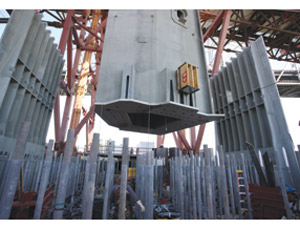In late July, four 1,200-ton, 165-ft-long steel segments were erected to become a tower for the $6-billion San Francisco-Oakland Bay Bridge’s self-anchored suspension span.

Under a $1.43-billion contract, the joint venture of American Bridge, Coraopolis, Pa., and Fluor Corp., Irving, Tex., used a strand-jack gantry positioned atop the erection tower to pull the segments off a barge, lift them straight up over the tower foundation, then lower them into place.
The first four tower sections, fabricated by ZPMC in Shanghai, arrived in the Bay Area on July 9, says Bart Ney, Caltrans’ spokesman. The tower is made up of four independent legs, and each leg is composed of five vertical sections. The 525-ft-tall tower’s marine box foundation is a footing, consisting of steel encased by concrete. It is 85 ft long, 73 ft wide and 21 ft deep.
The substructure for the footing consists of 13 concrete piles with steel casings. The 196-ft-long piles are anchored into bedrock. After the tower pieces are in place, workers will connect them with cross bracing and shear link beams.
“The shear link beams are perhaps the most unique design element of the bridge’s self-anchored suspension tower,” says Marwan Nader, lead design engineer for T.Y. Lin International, San Francisco.
The shear link beams are designed to absorb most of the seismic energy and yield during an earthquake, thereby allowing the four shafts of the main tower to move independently. The system protects the tower shafts from significant damage. If necessary, damaged shear link beams can later be replaced, says the engineer.

Post a comment to this article
Report Abusive Comment